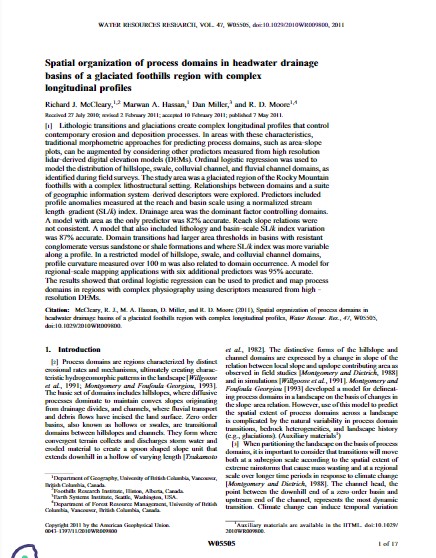Spatial organization of process domains in headwater drainage basins of a glaciated foothills region with complex longitudinal profiles
Bosque Modelo:
Foothills
Temática:
Conservación
Tipo de documento:
Artículo científico
Resumen
Lithologic transitions and glaciations create complex longitudinal profiles that controlcontemporary erosion and deposition processes. In areas with these characteristics, traditional morphometric approaches for predicting process domains, such as area‐slopeplots, can be augmented by considering other predictors measured from high resolutionlidar‐derived digital elevation models (DEMs). Ordinal logistic regression was used tomodel the distribution of hillslope, swale, colluvial channel, and fluvial channel domains, asidentified during field surveys. The study area was a glaciated region of the Rocky Mountainfoothills with a complex lithostructural setting. Relationships between domains and a suiteof geographic information system–derived descriptors were explored. Predictors includedprofile anomalies measured at the reach and basin scale using a normalized streamlength–gradient (SL/k) index. Drainage area was the dominant factor controlling domains.A model with area as the only predictor was 82% accurate. Reach slope relations werenot consistent. A model that also included lithology and basin‐scale SL/kindex variationwas 87% accurate. Domain transitions had larger area thresholds in basins with resistantconglomerate versus sandstone or shale formations and where SL/kindex was more variablealong a profile. In a restricted model of hillslope, swale, and colluvial channel domains,profile curvature measured over 100 m was also related to domain occurrence. A model forregional‐scale mapping applications with six additional predictors was 95% accurate.The results showed that ordinal logistic regression can be used to predict and map processdomains in regions with complex physiography using descriptors measured from high‐resolution DEMs
Información Bibliográfica
Autor:
McCleary, R.J., Hassan, M.A., Miller, D. & Moore, R.D.
Revista:
Water Resources Research
Año:
2011
N°:
-
País :
Canadá
Páginas:
-
Volumen:
47
Idioma:
Ingles
Palabras claves
digital elevation models, model forest





